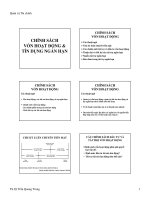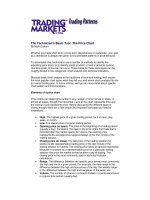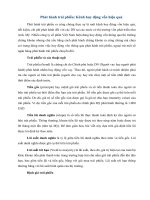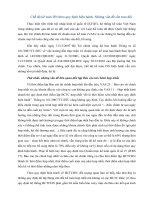Tài liệu What every real estate professional needs to know about surveying pdf
Bạn đang xem bản rút gọn của tài liệu. Xem và tải ngay bản đầy đủ của tài liệu tại đây (1.06 MB, 10 trang )
In common usage, the term ‘survey’ refers to a drawing of a parcel of real property.
This drawing depicts the results of the surveyor's measurements made in the field
and his or her interpretation of evidence relating to the location of the boundaries of
the property based on a legal description furnished to the surveyor. Surveying is a
process of direct measurement and analysis specifically designed to document the
existence, the identity, the location and the dimension or size of natural or artificial
features on land or in the air, space or water for the purpose of producing accurate
and reliable maps, suitable for visualization if needed, of such documentation.
There are numerous types of surveys:
• as-built (also called record)
• boundary
• condominium
• construction layout
• control
• hydrographic
• mean high water line
• quantity
• right-of-way
• special purpose
• topographic
The most commonly encountered type is the boundary survey, which determines the
perimeters of a parcel or tract of land by establishing or re-establishing comers,
monuments and boundary lines for the purposes of describing the parcel, locating
fixed improvements on the parcel, dividing the parcel or platting.
Surveys are a part of nearly all modern real estate transactions. Many institutional
lenders require a survey as a condition before making a loan secured by a mortgage
encumbering real estate. An accurate survey, coupled with a physical inspection of
the property, is by far the best way to determine the location of the boundaries of the
property and the location of improvements on the property. It will also show whether
the location of the property on the ground is the same as the written legal description.
The survey also adds value to your transactions by providing an additional level of
protection coverable through title insurance. Most real estate transactions in the
United States are covered by title insurance because of the protections it provides.
There are two common types of coverage provided by title insurance policies:
• Standard Coverage insures against defects in title, but won’t cover the
insured against the interests of persons in actual possession of property
(such as adverse possessors) or against interests that would be disclosed
by an inspection of the premises (such as an encroachment).
• Extended Coverage insures against everything included in Standard
Coverage, plus items not in the public record.
A current survey provides information that will allow a title insurance company to
delete the exception for matters of survey in the title insurance policy, such as
boundary lines, encroachments and parcel area.
A wise buyer will always obtain a survey to be certain that, among other things, the
property is in fact located where the buyer thinks it is located. Nothing is more
frustrating than discovering that the fence line is NOT the true property line, and your
buyers just ‘lost’ twenty feet of property to their new neighbor.
A seller will generally be less concerned about a survey than will a buyer, unless the
survey reveals problems or defects which the seller is obligated to remedy or unless
the purchase price is based on the quantity of property (normally in terms of acreage
or square feet) as determined by a survey.
When representing buyers, the agents’ duty is to protect their clients and
ensure that they pay the best possible price for a clearly defined property.
Conveying land from one party to another ALWAYS requires a clear and
accurate description of that property, because any ambiguities or
uncertainties in the legal description can invalidate a deed. A survey is the
best way to clearly and accurately define property.
Is a survey necessary for title insurance?
Extended Coverage title insurance is often called the mortgagee’s policy
because it is purchased by a buyer. The Extended Coverage policy insures
its purchaser against matters not included in the public record, effectively
protecting a property buyer from problems caused by unrecorded easements
or other defects in the title. Most buyers of property will purchase an
Extended Coverage title insurance policy to protect their interests, and a
survey is a necessary component of the Extended Coverage policy. A
commonly used survey for Extended Coverage complies with the American
Land Title Association specifications for a survey and is often called an ALTA
Survey. There is a more thorough discussion of ALTA Surveys later in this
article.
What if you have an existing survey?
You may have an older survey in your possession, perhaps given to
you by the seller’s agent. There are advantages and disadvantages to
using an existing survey instead of commissioning a new one:
Advantages:
• Useful to conceptualize property’s shape and size
• Inexpensive, often free
• Typically available in a short amount of time
Disadvantages:
• Not current, reflects information available only up to the date the
survey was completed
• May not include all of the information that is pertinent to your
transaction. Often, there have been changes to easements,
encroachments or other issues affecting the property that are not
shown on an outdated survey. Here are some examples of potential
problems:
o Utility company installation of new or updated
transmission lines
o Existing survey may not show the existence or location
of underground utilities that could affect the buyer’s
plans for the property.
• May not have been intended for use in property transfer. For
example, the survey may have been prepared only to locate one
property line for installation of a fence or other appurtenance, or for
construction of the house, and may not accurately reflect all the
encumbrances or other features on the property.
If the existing survey reveals problems such as evidence or unrecorded
easements or encroachments, the time to face those problems and deal with
them is before the contract is signed. Even if the seller’s agent does not have
a survey, he or she might know about survey problems. For example, a
neighbor may have built a fence or other structure that appears to cross over
the boundary line.
What if you are aware of survey-related problems in the pre-
contract stage of the transaction?
The buyer is relying on you to provide all of the real estate know-how
that they lack. As the buyer’s agent, you have a fiduciary responsibility
to disclose material facts, and a survey-related problem is clearly
material to any parcel of land. Therefore, it is in your best interests to
give them access to all the resources they need to make an informed
decision. If there are issues related to the boundary of the property or
other survey-related problems, it is up to you to steer your client
through the transaction.
• Possible Solution: One way to deal with survey-related problems
might be to provide in the contract that the particular survey
problems must be cured or eliminated by the seller within a specified
time period.
In any event, the nature and extent of the survey problems will dictate what
the parties decide to do (or not do) about them.
What if you have an existing survey?
You may have an older survey in your possession, either from the seller or
from another source. If the survey reveals problems such as evidence of
unrecorded easements or encroachments, the time to face those problems
and deal with them is before the contract is signed. Even if your seller client
does not have a survey, he or she might know about survey problems. For
example, a neighbor may have built a fence or other structure that appears to
cross over the boundary line. If your client informs you of these problems,
you have a duty to disclose these latent defects to the buyer.
What if you are aware of survey problems in the pre-contract
stage of the transaction?
Again, a selling agent has a duty to disclose latent defects, or defects that
are not discoverable by ordinary inspection, to the buyer. As a seller’s
representative, one way to deal with survey problems is to provide in the
contract that the particular survey problems do not constitute title defects, but
rather are deemed permitted exceptions. In any event, the nature and extent
of the survey problems will dictate what the parties decide to do (or not do)
about them.
Furnishing of Existing Surveys
Buyer: Begin by requiring that the seller, within a specified timeframe,
furnish all existing surveys of the property in his or her possession. Keep that
timeframe short - five days, say - since you’ll want to have existing surveys
on hand when ordering the new survey. Even though the current status of the
property may not be reflected on an existing survey, it will tell you and your
client a great deal about the property.
Seller: Require the buyer to return the existing surveys to the seller if the
transaction does not close.
Procurement of New Survey
State which party pays for the survey. Although the buyer normally pays for
the survey, this is often negotiable (as are virtually all terms of any real estate
contract).
Regardless of which party you represent, be sure that the following dates
and timeframes are internally consistent:
• deadline dates with respect to the delivery of the title insurance
commitment
• the time period for objections to the title insurance commitment
• the procurement of the survey
• the time period for objections to the survey
• the applicable curative periods as to title insurance commitment
objections and survey objections
• the closing date
• other key contract dates
Buyer:
Most contracts provide that the buyer may obtain a survey within a specified
timeframe, although in rare cases the seller is required to obtain the survey.
If the seller is required to procure the survey, provide in the contract for a
remedy in favor of the buyer if the seller fails to deliver the survey in a timely
manner. That remedy might be an extension of the inspection period, an
extension of the closing date or a reduction in the purchase price.
If your buyer has the option of procuring a survey, you may wish to
incorporate some flexibility into the contract so that your client does not have
to obtain (and hence pay) for the survey until 10 days or so before the
closing (or whatever time period your surveyor requires to complete the
survey). Keep in mind, however, that delaying procurement of the survey
increases the risk that you may have sufficient time to object to defects
revealed by the survey. It is generally preferable to obtain and review the
survey before the end of the inspection period in case the buyer wishes to
terminate the contract for any reason. Once the inspection period expires,
the seller's obligation to cure survey defects may be limited under other
provisions of the contract.
Seller:
Provide that the last day for obtaining the survey is no later than the last day
for delivery of the title insurance commitment; the delivery of the survey is
generally what triggers the commencement of the time period in which the
buyer must make objections. Some real estate professionals, especially
those representing buyers, prefer to require that the title insurance
commitment be delivered at least 10 days before the last day for obtaining
the survey; then, the surveyor may be given a copy of the title insurance
commitment in order to locate on the survey easements and other matters
listed on Schedule B of the title insurance commitment.
Survey Requirements
Typically, the specific survey requirements are not detailed in the real estate
contract because the buyer is paying for the survey and is able to specify the
requirements for the finished product directly with the surveyor. However, if
you represent the buyer and the seller is providing the survey, you should
specify the survey requirements in the contract to make sure that all of the
necessary information is included. There are varying degrees of information
that can be included on a survey, and you want to be sure your buyer sees
everything he or she needs to make an informed decision.
When drafting the contract, provide that problems or defects revealed by the
survey (that are not permitted exceptions under the contract) will be treated
as title defects under the paragraph of the contract concerning title matters.
Some examples of problems and defects that a survey might reveal include
the following:
• Easements that are not permitted exceptions under the contract.
• Rights of way that are not permitted exceptions.
• Violations of any building, zoning, land use, or other laws,
ordinances, rules, or regulations.
• Encroachments of improvements onto the lands of others, or
encroachments of others' improvements onto the property.
• Overlaps or missing slivers of property.
• Lack of legal access for either ingress and egress or utilities.
The survey might reveal variations between the legal description in the
contract and the actual measurements on the ground. Such variations are
often minuscule, and arise in large part because of the sophisticated
surveying equipment in use today. Most title insurance companies will issue
the Survey Endorsement when the variations are slight, and the surveyor
certifies that the legal description refers to the same property shown on the
survey notwithstanding the variations. That endorsement is an
acknowledgment by the title insurance company that the property described
in the title insurance policy is the same as that depicted on the survey.
Buyer:
Include a provision to the effect that survey defects include all matters that
would, in the buyer's sole opinion, interfere with the buyer's intended use of
the property.
Seller:
Provide that notwithstanding anything to the contrary contained in the
contract, survey matters shall not be treated as title defects if the title
insurance company agrees to remove the standard exception for matters of
survey and does not insert in its place a specific exception relating to the
particular potential title defects or to matters appearing on the survey in
general.
Seller's Inability to Cure Defects
Buyer:
Provide that if the transaction does not close because the seller is unable to
cure or eliminate problems or defects (revealed by the title insurance
commitment or the survey), the seller must reimburse the buyer for the cost
of the survey.
Multiple Legal Descriptions
Buyer:
The property might be described by metes and bounds in the instrument by
which the seller acquired title and in the survey by reference to several
separate legal descriptions. You should specify that if the surveyor writes a
combined or aggregate legal description and certifies that the new legal
description describes the same property as the combined old legal
descriptions, the seller will convey the property using the new legal
description.
Seller:
If the subject property has multiple legal descriptions and the surveyor writes
and certifies a new legal description, you should ask that the instrument of
conveyance include, after the new legal description, the phrase "also
described as" followed by the old legal descriptions. Including the old legal
descriptions clarifies the seller’s intent to convey the property.
If the property includes several parcels, request that the title insurance
company issue, with the title insurance policy, the Contiguity Endorsement.
That endorsement ensures that the parcels in question are contiguous to
each other and that, taken as a tract, constitute one parcel of land. As a
condition to issuing it, the title insurance company might require a
certification by the surveyor that the parcels are in fact contiguous.
Who Orders the Survey?
Depending on your clients’ level of sophistication, they may order the survey
or they may ask you to order the survey. If you are not the one who orders
the survey, always confirm that it has in fact been timely ordered and that
the survey specifications include all of the necessary information. In
residential transactions, the broker or the title insurance agent often orders
the survey. In commercial transactions, the real estate professional rather
than the client should normally order the survey. That way, all of the
requirements will be timely and properly communicated to the surveyor and
delays avoided. Even if you do not place the initial order for the survey, at
some point you will communicate with the surveyor as to the form and
content of the survey.
How and When to Order Survey
Your client may instruct you to use a particular surveyor. If not, choose an
experienced, reputable, dependable, local surveyor; keep in mind that such a
surveyor may not be the least expensive one. The ProposalPlanet.com
website will help you find and select a qualified surveying firm. You should
discuss the following items with the potential surveyor:
• Timeframe. As soon as the contract is signed, call the surveyor
and inquire about how much time it will take, at most, to receive the
survey once it is ordered. When scheduling for delivery of the survey,
it is wise to give yourself a cushion of at least a few days to allow for
unexpected delays, especially since surveyors may get backlogged
due to inclement weather.
• Scope of Work. To give an accurate estimate of the time and
cost, the surveyor will need to know what the basic requirements for
the survey will be. Send (or fax) the legal description, specific
instructions and a proposed form of surveyor's certificate as soon as
possible. You can also use services such as ProposalPlanet.com to
find capable firms, then request and receive proposals from the
selected land surveyors.
• Fee Quotation. Ask the surveyor for a fee quotation, and then be
sure this is acceptable to the client. Be sure to carefully balance
qualifications and fees. Surveyors should not be selected based on
price alone; your clients are paying for a professional service and for
expertise in a specific area and specialty.
• Payment Responsibility. If you are ordering the survey on your
clients’ behalf, make sure that the surveyor understands that your
client not you is responsible for payment, unless you have the
money in your trust account and your client’s authorization to use it
to pay the surveyor's bill.
• Documentation. Send (or fax) a letter to the surveyor confirming
that the survey will be delivered to you by the date promised. Be
sure to enclose the following:
o legal description
o your specific instructions and requirements (including the
title insurance company's requirements for deletion of the
survey exception)
o a list of the contract’s permitted exceptions
o a copy of the title insurance commitment (with copies of all
Schedule B exceptions)
o the proposed surveyor's certificate.
o Number of copies needed, factoring in the copies required
for you, your client, the seller and his or her attorney, the title
insurance company, and the lender
You should also confirm the fee and the payment arrangement.
Inform the surveyor as to the buyer's planned use of the property, in
order to assist the surveyor in defining the scope of the survey. It is
also a good idea to alert the surveyor about any boundary problems
of which you are aware. Call the surveyor two or three days later to
be sure the information has been received.
General Notes about Ordering Surveys
Surveyor’s Certificate - The contents of the surveyor's certificate may
have to be negotiated with the surveyor. In negotiating the form of the
surveyor's certificate, do not ask the surveyor to certify to matters that are not
appropriate for the surveyor to certify to, either because they are prohibited
by the statutes and rules that bind surveyors or because they are beyond the
scope of the surveyor's function.
Does a Boundary Survey Include Improvements? - There is some
ambiguity as to whether the term “boundary survey” refers to a survey that
shows improvements such as buildings or not. Never rely on a boundary
survey alone, unless all you are interested in is the perimeter of the property.
Instead, ask for a survey that shows all improvements. Using the descriptive
names "boundary and improvements survey" or "boundary and location
survey" alleviates much of the confusion, even though those types of surveys
are not expressly defined in many local codes.
Lender Requirements - The lender will sometimes impose requirements
for the survey that are more onerous than (or at least different than) those
you have imposed on behalf of your buyer client. This is more likely to be the
case in a large commercial transaction. The best approach in that situation is
to initiate communication between yourself, the surveyor and the lender's
attorney as early as possible so all parties understand the scope of the
surveyor’s work and are satisfied with it. As a buyer's representative,
remember that a lender may be involved in the transaction at some point, so
try you should try to anticipate a typical lender’s requirements when you
order the survey.
Deadlines - When you represent the buyer, or in the rare case the seller
who is required under the contract to procure the survey, place an
appropriate notation on your calendar or in your tickler system to be sure you
receive the survey by the deadline. If you receive the survey after the
deadline, the contract may have been breached and your time for reviewing
the survey and making objections as to defects on behalf of the buyer has
been shortened or eliminated. If you know that there will be a delay and that
the surveyor may not deliver the survey until after the deadline provided for in
the contract, contact the seller's attorney right away. Ask for a modification of
the contract extending the deadline.
Revisions - If the survey delivered to you does not meet the contract's
requirements, or those which were furnished the surveyor, request that a
revised survey be delivered to you as soon as possible. Some surveyors will
provide a preliminary survey for your review and comment prior to finalizing
the survey.
General Requirements
Unless you specifically request that the survey cover the items listed below,
the survey might not show them, since many of these items are not part of
the minimum technical standards. Items from the following list can be
incorporated into your instructions to the surveyor, but be sure to delete any
that are not pertinent to your transaction and to add any that are pertinent.
As a general guide, you should request that the survey include some
combination of the following:
1) Be prepared by a professional surveyor, duly licensed in your state.
2) Show the boundaries of the property and the location and
dimensions of all improvements located thereon.
3) Contain a certification indicating that it meets (or exceeds) the
minimum technical standards set in your state’s laws.
4) Be signed by the surveyor, dated and sealed.
5) Show a prominent north directional arrow and scale of the drawing.
6) Contain a metes and bounds or platted legal description which is
identical to that set forth in the contract. A metes and bounds
description will enable one reviewing the survey to trace the legal
description of the property by following the bearings and distances
around the boundaries as shown on the survey, while the platted
legal description will refer to a specific lot within a subdivision.
7) Show, if known, the street address.
8) Show interior lot lines, if applicable.
9) Show the location of walkways, paved areas, driveways and curb
cuts, both on the property and adjacent to the property's boundary.
10) Tie into a legally established point of beginning such as a section or
quarter section comer or a block comer in a platted subdivision.
11) Fix all corners with appropriate monuments unless sufficient
monumentation is already in place.
12) Show the 100-year flood plain contour line, if applicable.
13) Indicate the flood zone and map number in which the property is
located on the applicable FEMA flood map, if applicable.
14) Indicate the gross area of the property, in acres and in square feet.
This is especially important if the purchase price is based on the
acreage or square footage of the property.
15) Depict any easements that affect the property. Easements that
benefit the property, as well as those that burden it should be shown.
All easements should be referenced by recording data (i.e. official
records book and page).
16) Contain a statement that the means of access to and from the
property is by a specified public roadway.
17) Show any roadways or alleys that abut the property, whether public
or private. Names of the roadways, along with their widths and
distances from the property, should be shown too. If the property is
not abutted by a public roadway, the survey should show the location
of the nearest public roadway and its distance from the property.
18) Show the following:
• Location and dimensions of all visible utility connections and
service lines;
• Location of setback lines, whether mandated by restrictive
covenants, any applicable plat, or by building, zoning, land
use, or other laws, ordinances, rules or regulations imposed
by governmental authority;
• Location and dimensions of natural and manufactured
objects affecting the property;
• Location of ditches, creeks, canals and other like objects;
and
• All of the contract's permitted exceptions and all exceptions
in the title insurance commitment, to the extent that the
same are locatable on a survey.
19) Show any encroachments or discrepancies between the legal
description of the property as set forth in the contract and any
markers or monuments on the ground designating the boundaries of
the property as actually used and occupied.
20) Be certified to the buyer, the seller, the title insurance company, the
agent for the title insurance company, and any lending institution be'
granted a mortgage encumbering the property as part of the
transaction.
ALTA Surveys
The Minimum Standard Detail Requirements for ALTA/ACSM Land Title
Surveys were adopted by the American Land Title Association (ALTA) and
the American Congress on Surveying & Mapping (ACSM). The most recent
revision occurred in 1999. These standards can be obtained through ALTA
or downloaded from the ProposalPlanet.com website.
Reviewing the Survey
Whether you represent the buyer, the seller or the lender, you must be able
to review, analyze and understand the survey. Although your skill in
reviewing surveys is most important when representing buyers and lenders,
you should be familiar enough with surveys and legal descriptions to spot
any significant errors the surveyor may have made.
Buyer:
The entire survey must be reviewed carefully, and discussed with your client,
informing him or her of any problems or issues raised by the survey. In
general, you want to ensure that the survey meets the contract’s
requirements and the requirements set forth in your instructions to the
surveyor, that the surveyor's certificate is acceptable and that the survey
reveals no problems that were not already known. As the buyer’s agent,
make any objections to survey defects within the time period and in the
manner provided for in the contract. Objections to survey defects are usually
made in the same manner as objections to title defects.
Seller:
Your review of an existing (i.e. older) survey might occur before the contract
is signed, in which case you will need to spot any problems that the seller
should address before signing a contract or which should be addressed in
the contract. Your review of the new survey (i.e., the one normally obtained
by the buyer under the contract) when representing the seller will probably be
limited to determining whether objections made by the buyer are valid. If the
purchase price is based on the quantity of property, you will need to verify
this information from the survey as well.
All Parties:
Review the survey as soon as you receive it. Be sure your client has a copy
of the survey, and that he or she reviews it. Because of your client's
familiarity with the property, the survey might alert your client to problems
that you might not be aware of. For example, the client might suddenly
realize that the property is smaller or configured differently than he or she
thought.
Start with the legal description - Start by comparing the legal description in
the survey to the legal description in the title insurance commitment. There
should be no variations. If variations are found, object to them. Follow the
calls on the drawing around the boundaries of the property, looking for
discrepancies, encroachments, and other problems. The drawing should
conform to the legal description shown on the survey. Carefully examine the
survey for any matters defined as survey defects under the contract such as
encroachments, easements, setback violations and other matters that are not
within the permitted exceptions under the contract.
Read the entire survey and any accompanying report. Once you become
familiar with surveys, this task will not seem as daunting. If you only read part
of the survey, or if you give it only a cursory reading, you run the risk of
missing something important.
Old surveys and affidavits - Some title insurers will permit the deletion from
the title insurance policy of the standard exception for matters of survey
based on an older survey coupled with an affidavit of the current owner
establishing that there have been no material changes. If you represent a
buyer in a situation where a title insurer has agreed to accept an old survey
with an affidavit as the basis for deletion of the survey exception, you may
wish to have the survey certified to your client and the current title insurance
company by a surveyor. Most surveyors, however, are reluctant to certify a
survey when they have not completed the field work themselves.
Be sure to inform your client of the risk involved in such a procedure. The
old survey may no longer be accurate and the owner may fail (intentionally or
not) to disclose material changes that could seriously impact the subject
property.









